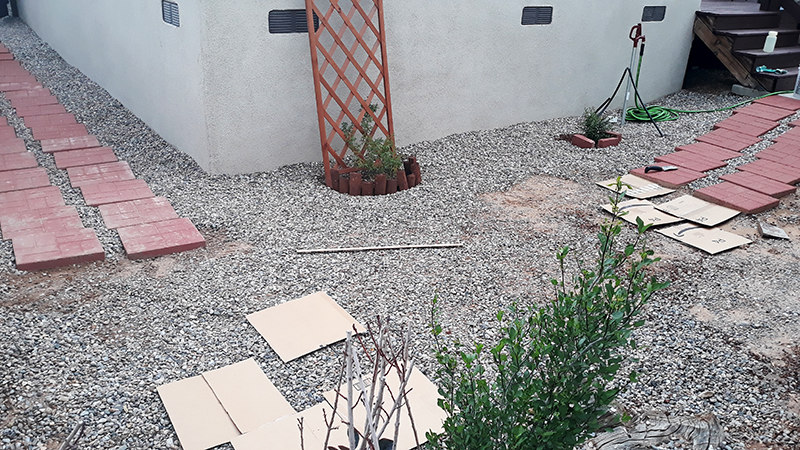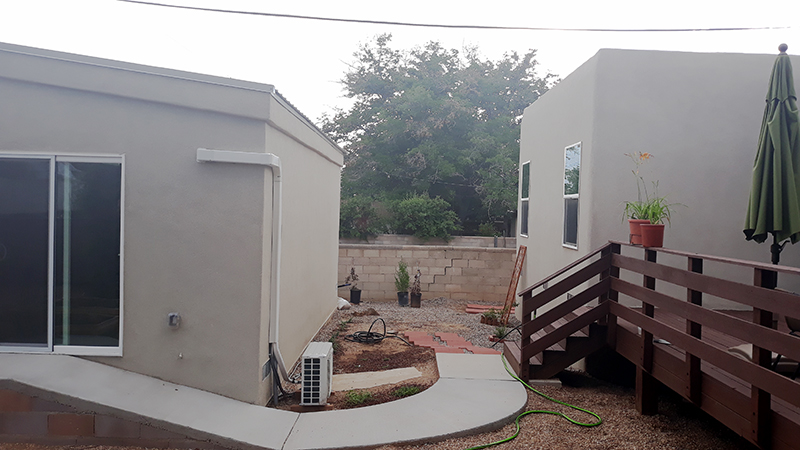Some Thoughts on Allyship and Path Building
BY EMMALY WIEDERHOLT
I’ve been busy during the coronavirus quarantine building a path from the front of my house around the side to the back, where I have a small dance studio. My house is not wheelchair accessible, but the studio is, with a ramp leading up to it. So I bought a bunch of brickface and have been installing a 36” wide path around the house to the ramp in the hopes that, after the coronavirus danger is over, any friends who might want to come dance in my studio could access it, including friends who use wheelchairs. Each brickface is heavy; I can place six a day at most, and I’ve had my fair share of cuts, bruises, and broken fingernails. Each brick is also difficult to lay, as the ground in New Mexico is rocky and the soil is hard clay. After about two months of this labor, the end is near, and I’m proud. I consider it my privilege to beautify my space and create better access for others.
In America, we’re in the wake of a crucial coming to terms. Like so many, I am horrified by the recent and ongoing events of police brutality that have rocked our country for the nth time. As a white cis-het able-bodied lady, I wonder what my role is in making the world a more equitable place. I like to think of myself as an ally, but I am not always sure of the best path forward.
The horrible and incontrovertible fact is that some bodies are valued more than others. This has been true throughout human history. I once got in a heated argument with my best friend about whether fundamental human progress is possible. I was arguing that it wasn’t, though I’ve since wondered if I was wrong. Isn’t contraception, the ADA, and legalized gay marriage evidence of progress? On the other hand, isn’t the systemic violence against Black bodies – both in the form of outright terror that George Floyd and so many others experience daily and in the sinister health outcomes that people of color are unproportionally suffering during this coronavirus pandemic – evidence that little real progress has been made?
Theory and reality never have a perfect path between them. I have struggled with how best to show solidarity with the recent protests. In thinking about the episodic violence that has accompanied them, I can understand and empathize with the idea that Black lives are more important than property, and also feel like a hypocrite because I know I would not feel comfortable if my own property – my home or small business – was in danger of being destroyed. Is it enough of a showing of solidarity to post something on social media and then go back to enjoying and protecting my place of privilege? It’s like saying Black bodies and spaces deserve to be heard and valued, but please don’t compromise the wellbeing of my body and space. This incongruity makes me feel deep shame.
Some bodies are made to feel more valued than others, and in few spaces is this truer than the dance world. Thin bodies are valued more than fat bodies (just look at any dance poster), able bodies are valued more than disabled bodies (despite the enormous strides that the disability dance community has made in the past decade), and white bodies are still valued more than Black and Brown bodies. If this sad fact weren’t true, Misty Copeland wouldn’t have made news in 2015 for being the first (and still only) Black female principal at ABT. She would just be another awesome dancer.
Over the next two months, Stance on Dance will feature several interviews from the Discussing Disability in Dance Project, a book project I am working on with Silva Laukkanen and Liz Brent-Maldonado. I have loved conducting interviews for this project and challenging myself to contemplate ways our dance community might find value in all bodies. I encourage you to read any/all the interviews here: https://stanceondance.com/discussing-disability-in-dance/ and follow Stance on Dance to stay up to date as new interviews are published. This project has allowed me to understand, for instance, that it’s one thing to say I’m for more representation and opportunities for dance artists with disabilities, and another to build a path allowing that to happen on a micro level in my own backyard. For real change to happen, we have to trek the long hard introspective path assessing the ways we individually and collectively deny people access all the time, signaling our preference for some bodies over others.
As for my garden path, I’m not sure if/when it will be accessed by a wheelchair user. And I worry that the little bumps along the way might make it a bit uncomfortable to roll along. In many ways, it would have been easier to not build the path and just mourn the state of the world for its bouquet of inequalities and eventually move on. Allyship is always an imperfect path but, from my vantage point, attempting to build access – to studios, to social safety nets, and to justice – is the most important work we can do.
~~
~~


